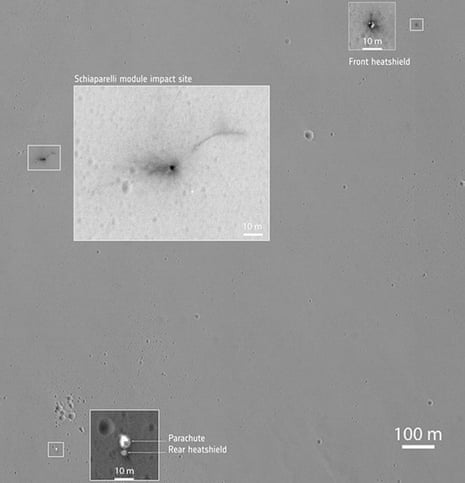The European Space Agency has released new images of its doomed Mars lander, which is thought to have disintegrated after hitting the planet’s surface at high speed – rather than touching down gently as planned.
A giant crater caused by the Schiaparelli spacecraft’s impact can be made out and visible nearby are two different components of the lander – its heatshield and parachute.
The images show that the craft touched down well within its target landing zone, but that something went catastrophically wrong during the descent.
The pictures, taken by Nasa’s Mars Reconnaissance Orbiter, could help reconstruct the exact chain of events that led to the failure of the lander.
They show a fuzzy patch of about 15 metres by 40 metres, indicating an impact crater 50cm deep, with a central dark spot.
The irregular shape of the crater suggests that the fuel tanks, containing hydrazine propellant, may have exploded, throwing up debris.
Data beamed back from Schiaparelli during its descent suggests its parachute worked correctly, but that its thrusters only fired for three or four seconds rather than 30 seconds as intended. Schiaparelli continued transmitting for a further 19 seconds before going silent.
Scientists think that after the thrusters switched off, Schiaparelli fell in freefall from a height of between 2km and 4km (1.25-2.5 miles) and hit the surface at a speed of more than 300 km/h (186mph).
While engineers hope to learn from any glitches that befell Schiaparelli, a question mark hangs over the future of the ExoMars rover because of a £300m funding gap at ESA.
Jan Woerner, ESA’s director general, said he believed that ministers of member states – who are being asked to cover the funding shortfall – would not be deterred by the probe falling at the final hurdle.
“I think they will see – we will show this mission is a success,” he told a press conference last week. “We don’t have to convince them, we just have to show them – the results are obvious.”

Comments (…)
Sign in or create your Guardian account to join the discussion